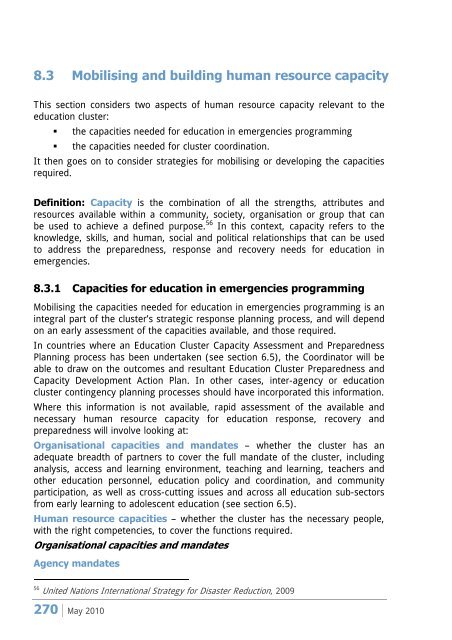Advocacy and resource mobilisation - OneResponse
Advocacy and resource mobilisation - OneResponse
Advocacy and resource mobilisation - OneResponse
You also want an ePaper? Increase the reach of your titles
YUMPU automatically turns print PDFs into web optimized ePapers that Google loves.
8.3 Mobilising <strong>and</strong> building human <strong>resource</strong> capacity<br />
This section considers two aspects of human <strong>resource</strong> capacity relevant to the<br />
education cluster:<br />
� the capacities needed for education in emergencies programming<br />
� the capacities needed for cluster coordination.<br />
It then goes on to consider strategies for mobilising or developing the capacities<br />
required.<br />
Definition: Capacity is the combination of all the strengths, attributes <strong>and</strong><br />
<strong>resource</strong>s available within a community, society, organisation or group that can<br />
be used to achieve a defined purpose. 56 In this context, capacity refers to the<br />
knowledge, skills, <strong>and</strong> human, social <strong>and</strong> political relationships that can be used<br />
to address the preparedness, response <strong>and</strong> recovery needs for education in<br />
emergencies.<br />
8.3.1 Capacities for education in emergencies programming<br />
Mobilising the capacities needed for education in emergencies programming is an<br />
integral part of the cluster’s strategic response planning process, <strong>and</strong> will depend<br />
on an early assessment of the capacities available, <strong>and</strong> those required.<br />
In countries where an Education Cluster Capacity Assessment <strong>and</strong> Preparedness<br />
Planning process has been undertaken (see section 6.5), the Coordinator will be<br />
able to draw on the outcomes <strong>and</strong> resultant Education Cluster Preparedness <strong>and</strong><br />
Capacity Development Action Plan. In other cases, inter-agency or education<br />
cluster contingency planning processes should have incorporated this information.<br />
Where this information is not available, rapid assessment of the available <strong>and</strong><br />
necessary human <strong>resource</strong> capacity for education response, recovery <strong>and</strong><br />
preparedness will involve looking at:<br />
Organisational capacities <strong>and</strong> m<strong>and</strong>ates – whether the cluster has an<br />
adequate breadth of partners to cover the full m<strong>and</strong>ate of the cluster, including<br />
analysis, access <strong>and</strong> learning environment, teaching <strong>and</strong> learning, teachers <strong>and</strong><br />
other education personnel, education policy <strong>and</strong> coordination, <strong>and</strong> community<br />
participation, as well as cross-cutting issues <strong>and</strong> across all education sub-sectors<br />
from early learning to adolescent education (see section 6.5).<br />
Human <strong>resource</strong> capacities – whether the cluster has the necessary people,<br />
with the right competencies, to cover the functions required.<br />
Organisational capacities <strong>and</strong> m<strong>and</strong>ates<br />
Agency m<strong>and</strong>ates<br />
56 United Nations International Strategy for Disaster Reduction, 2009<br />
270 | May 2010











